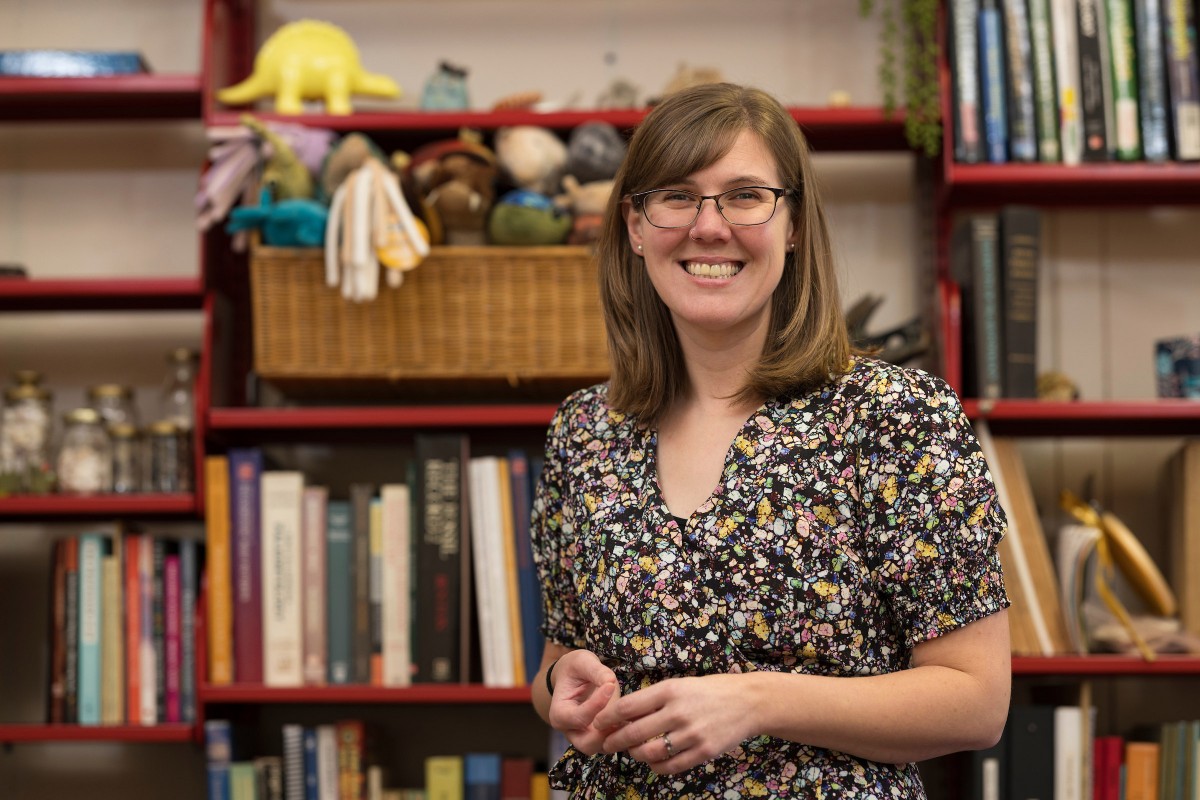Sea star: Research explores the diversity of shapes among ancient echinoderms
Assistant Professor Sarah Sheffield also explores issues of diversity, equity and inclusion in the sciences

Echinoderms take a dazzling variety of shapes, from sand dollars to starfish, the feathery-limbed sea lily, and the pincushion-like sea urchin.
There are five living groups of echinoderms today, but at one time, there were more than 30 — and some looked downright odd.
“The ones that are extinct have these weird body forms, phenomenally strange things like giant arms or bodies that are shaped like bass guitars,” Binghamton University Assistant Professor of Earth Sciences Sarah Sheffield said. “We don’t fully understand why they were so morphologically diverse.”
That’s what Sheffield aims to find out. A native of North Carolina, the paleontologist came to Binghamton this semester by way of Florida, where she spent six years at the University of South Florida’s School of Geosciences. She has a grant from the National Science Foundation to study ancient echinoderms — which species survived, and which had expanding or contracting ranges.
Scientists don’t yet know how the different types of echinoderms are evolutionarily related to one another, or the impact of ocean conditions on body shape. The average starfish has more than a million pieces to its body, and the chances of finding all those pieces in the fossil record are slim, she acknowledged.
“My first job is to figure out how they’re related to each other. That takes looking at a lot of fossils in the field or in museums to look for patterns we may not have seen before, before going to parts of the world that haven’t yet been explored for fossils,” Sheffield said.
Today, echinoderms typically live in deeper water; in the past, some lived in shallower seas. Scientists don’t yet know what prompted the shift, such as changes in temperature or the chemical composition of the ocean.
They have weathered a lot of environmental changes through the ages. The climate was much warmer 400 million years ago, with sea levels 200 meters higher than they are today, Sheffield explained. Around 250 million years ago, this hotter Earth experienced the Permian–Triassic extinction, often dubbed the Great Dying; 96 percent of marine species and 70 percent of those on land were wiped out. In other, colder periods, glaciation reached close to the equator.
“If we see which body plans survived and which didn’t, we can potentially predict what biodiversity might be like in the future,” she said.
As a paleontologist, Sheffield looks to the Earth’s deep past — but she also has an eye on the discipline’s future, through her emphasis on diversity, equity and inclusion.
Equity in the lab and field
Historically, Earth Sciences were extractive; geologists went into the field and took things, often without the permission of the indigenous population. Many of the leaders of the United States’ westward expansion were creating geologic maps while displacing Indigenous peoples, Sheffield pointed out. Paleontologists have also dug out and taken fossils back to their labs to study and typically don’t return them to their country of origin — which is why, for example, some of the best places to study the Moroccan fossil record are in the United States.
“It creates a lot of inequity because the funding for science isn’t necessarily in the same place where the science is being done. We’re taking scientific and cultural resources from other countries,” she said.
Inequity is also present in other ways. Many geology degree programs require field courses; imagine, for example, spending six weeks hiking out West during the summer.
Students with physical disabilities aren’t able to participate, nor are those with financial limitations, children, or caregiving and professional responsibilities. Some students also may not feel safe in rural areas where fieldwork is likely to take place.
It’s an issue that speaks to Sheffield’s own experience as an undergraduate. She required special permission to opt out of the required six-week field course and take courses during the main semester instead.
“I was attending college on a full, needs-based scholarship, and needs-based scholarships don’t cover summer courses. I couldn’t afford the thousands of dollars in tuition,” she said.
Sheffield has published research on how geoscience organizations can become anti-racist and make the field more inclusive. One of these suggestions would remove fieldwork camps as a requirement, with lab-based career-building courses as an equal alternative to field courses — and one more reflective of the field’s computer-based reality.
Excluding voices ultimately doesn’t serve the interdisciplinary and collaborative nature of science and the expansion of knowledge, she pointed out.
“We have to ask ourselves when we create these types of requirements: Are we telling people that they can’t be a geology major? And when we do that, whose voices are we keeping out of geology?” Sheffield asked. “We’re automatically excluding some people from the get-go.”
